
Shenzhou is a Chinese spacecraft developed for the nation's crewed space program. Its design was based on Russia's Soyuz, but larger and modernized, Shenzhou is a single-use vehicle composed of three modules. The descent module houses the crew during launch and reentry. The orbital module provides additional living space and storage during orbit but is jettisoned before reentry. The service module, responsible for propulsion and power, is also discarded prior to reentry. For added safety and aerodynamics, the spacecraft is encased within a fairing with a launch escape system during liftoff.
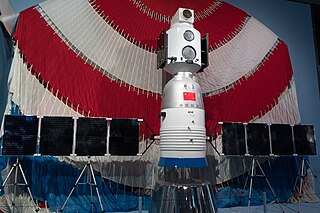
Shenzhou 5 was the first human spaceflight mission of the Chinese space program, launched on 15 October 2003. The Shenzhou spacecraft was launched on a Long March 2F launch vehicle. There had been four previous flights of uncrewed Shenzhou missions since 1999. China became the third country in the world to have independent human spaceflight capability after the Soviet Union and the United States.
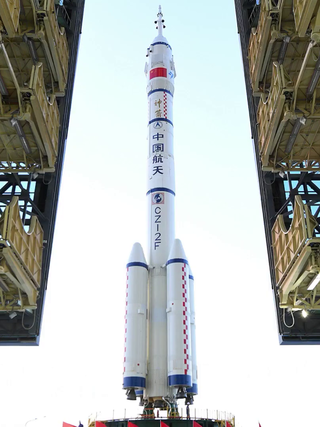
The Long March 2F, also known as the CZ-2F, LM-2F and Shenjian, is a Chinese orbital carrier rocket, part of the Long March 2 rocket family. Designed to launch crewed Shenzhou spacecraft, the Long March 2F is a human-rated two-stage version of the Long March 2E rocket, which in turn was based on the Long March 2C launch vehicle. It is launched from complex SLS at the Jiuquan Satellite Launch Center. The Long March 2F made its maiden flight on 19 November 1999, with the Shenzhou 1 spacecraft. After the flight of Shenzhou 3, CPC General Secretary and President Jiang Zemin named the rocket "Shenjian", meaning "Divine Arrow".
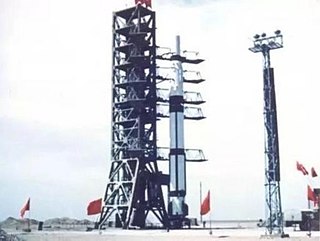
The space program of the People's Republic of China is about the activities in outer space conducted and directed by the People's Republic of China. The roots of the Chinese space program trace back to the 1950s, when, with the help of the newly allied Soviet Union, China began development of its first ballistic missile and rocket programs in response to the perceived American threats. Driven by the successes of Soviet Sputnik 1 and American Explorer 1 satellite launches in 1957 and 1958 respectively, China would launch its first satellite, Dong Fang Hong 1 in April 1970 aboard a Long March 1 rocket, making it the fifth nation to place a satellite in orbit.
Shenzhou 4 – launched on December 29, 2002 – was the fourth uncrewed launch of the Chinese Shenzhou spacecraft. Two dummy astronauts were used to test the life support systems.
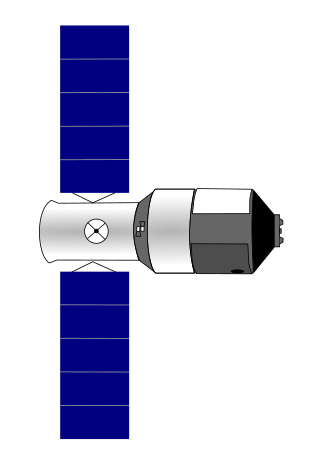
The Tiangong program is China's space program to create a modular space station, comparable to Mir. This program is independent and unconnected to any other international space-active countries. The program is part of the China Manned Space Program that began in 1992. The core module of the Tiangong space station, the Tianhe was finally launched on 29 April 2021 marking the start of the Tiangong Space program deployment.

Tiangong, officially the Tiangong space station, is a permanently crewed space station constructed by China and operated by China Manned Space Agency. Tiangong is a modular design, with modules docked together while in low Earth orbit, between 340 and 450 km above the surface. It is China's first long-term space station, part of the Tiangong program and the core of the "Third Step" of the China Manned Space Program; it has a pressurised volume of 340 m3, slightly over one third the size of the International Space Station. The space station aims to provide opportunities for space-based experiments and a platform for building capacity for scientific and technological innovation.

Shenzhou 9 was the fourth crewed spacecraft flight of China's Shenzhou program, launched at 18:37:24 CST, 16 June 2012. Shenzhou 9 was the second spacecraft and first crewed mission and expedition to dock with the Tiangong-1 space station, which took place on 18 June. The Shenzhou 9 spacecraft landed at 10:01:16 CST on 29 June in the Inner Mongolia Autonomous Region. The mission's crew included the first Chinese female astronaut, Liu Yang. The next mission was Shenzhou 10, which launched on 11 June 2013.

The China Manned Space Program, also known as Project 921 is a space program developed by the People's Republic of China and run by the China Manned Space Agency (CMSA) under the Equipment Development Department of the Central Military Commission, designed to develop and enhance human spaceflight capabilities for China. It was approved on 21 September 1992 and has been in operation ever since. The CMS commander and director are currently Xu Xueqiang and Zhou Jianping respectively; the latter has held this position since 2006, after taking over from Wang Yongzhi, who served as the first director from 1992 to 2006.

Tianhe, officially the Tianhe core module, is the first module to launch of the Tiangong space station. It was launched into orbit on 29 April 2021, as the first launch of the final phase of Tiangong program, part of the China Manned Space Program.

The Tianzhou is a Chinese automated cargo spacecraft developed from China's first prototype space station Tiangong-1 to resupply its modular space station. It was first launched on the Long March 7 rocket from Wenchang on April 20, 2017 and demonstrated autonomous propellant transfer.

Tianzhou 2 was a mission of the Tianzhou-class unmanned cargo spacecraft. The launch took place at 29 May 2021, 12:55:29 UTC. The spacecraft successfully docked with the Tiangong space station later on the same day.
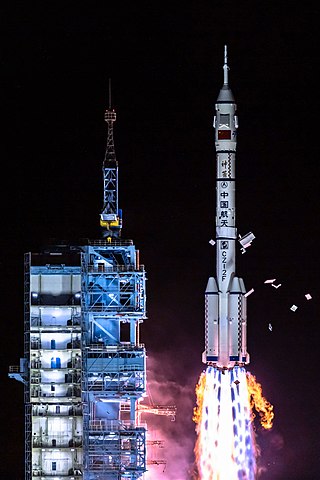
Shenzhou 13 was a Chinese spaceflight to the Tiangong space station, launched on 15 October 2021. It carried three People's Liberation Army Astronaut Corps (PLAAC) taikonauts on board a Shenzhou spacecraft. The mission was the eighth crewed Chinese spaceflight and the thirteenth flight overall of the Shenzhou program.
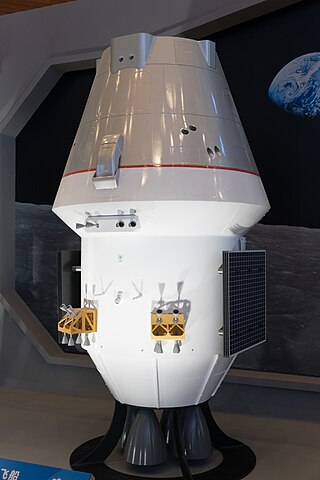
The Mengzhou, formerly known as the Next-Generation Crewed Spacecraft, is a type of reusable spacecraft developed and manufactured by China Aerospace Science and Technology Corporation (CASC). The prototype of the spacecraft underwent its first uncrewed test flight on 5 May 2020.

Senior Colonel Tang Hongbo is a Chinese fighter pilot and People's Liberation Army Astronaut Corps (PLAAC) taikonaut. He flew on his first spaceflight to the Tiangong space station as a part of the Shenzhou 12 mission, the first to visit the station. He was the commander of the Shenzhou 17 mission, making him the first taikonaut to visit Tiangong twice.

Tianzhou 4 was the fourth mission of the Tianzhou-class uncrewed cargo spacecraft, and the third resupply mission to Tiangong Space Station carrying 5 tons of cargos and 1 ton of propellant. It is the largest load capacity cargo spacecraft that is on active duty. It launched on 9 May 2022, docking successfully with the Tiangong space station at the aft port 6 hours after launch. Like previous Tianzhou missions, the spacecraft launched from the Wenchang Satellite Launch Center in Hainan, China on a Long March 7 rocket.
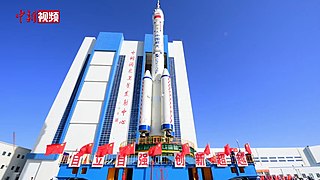
Shenzhou 14 was a Chinese spaceflight to the Tiangong space station, launched on 5 June 2022. It carried three People's Liberation Army Astronaut Corps (PLAAC) taikonauts on board a Shenzhou spacecraft. The mission was the ninth crewed Chinese spaceflight and the fourteenth flight overall of the Shenzhou program.
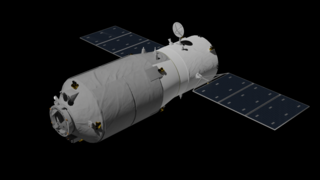
Tianzhou 6 was the sixth mission of the Tianzhou-class uncrewed cargo spacecraft, and the fifth resupply mission to the Tiangong Space Station. Like previous Tianzhou missions, the spacecraft was launched from the Wenchang Satellite Launch Center in Hainan, China on a Long March 7 rocket. This was the first mission of the operation phase of Tiangong. It was launched on 10 May 2023 at 13:22 UTC, and docked to the Tiangong Space Station a few hours later.

Shenzhou 18 was a Chinese spaceflight to the Tiangong space station, launched on 25 April 2024. It carried three People's Liberation Army Astronaut Corps (PLAAC) taikonauts on board a Shenzhou spacecraft. The mission was the thirteenth crewed Chinese spaceflight and the eighteenth flight overall of the Shenzhou program.
























